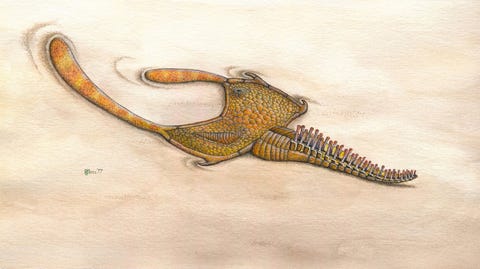A 150-Year Old Weird Ancient Animal Mystery, Solved
The stylophoran was weird. At long last, scientists know how to classify it.
By David Grossman RICH MOOI/CALIFORNIA ACADEMY OF SCIENCE
RICH MOOI/CALIFORNIA ACADEMY OF SCIENCEWhat, exactly, was a stylophoran? That question is a minor mystery that has gnawed at scientists since the tiny fossilized creatures were first discovered 150 years ago.
The stylophorans' tiny, confusing bodies resembled a hybrid of primitive vertebrates and starfish. But now, after a century and a half of struggle, scientists have finally placed the animal within its appropriate family. Bertrand Lefebvre of with the French National Center for Scientific Research (CNRS) and the Laboratoire de Géologie in Lyon, France, discovered that the millennia-old mystery animal is, in fact, an echinoderm—from the same family as a starfish.
As you can see in the picture above, stylophorans had appendages that appeared to be tails, reminiscent of modern vertebrate animals like salamanders. Instead of spines, though, they had primitive vertebrate composed of calcite plates.
It wasn't until Lefebvre and his team discovered a specimen with preserved soft tissue that the animal's origins could be clarified. That's because these plates would preclude the need for backbones, leaving the stylophorans seeming more like echinoderms—relatives to peaceful sea dwellers like the sea urchins, sea cucumbers, and starfish we know today. However, these marine creatures are widely known for their symmetry in shape, whereas stylophorans are amorphous and strange in physical composition.
Lefebvre led the team that recently made the discovery of a fossilized stylophoran complete with much of its soft tissue. Soft tissue such as muscle do not typically fossilize, but these were preserved as the mineral pyrite.

A map of the iron distribution within a stylophoran appendage. The pieds ambulacraires are hollow tubes for feeding and locomotion.
BERTRAND LEFEBVRE / LGL-TPE / CNRS
The fossils were discovered in 2014 at the Fezouata Formation, near the Sahara Desert, a region known for its records of ancient marine life. Just one of 450 stylophoran fossils present at the site, each approximately 478 million years old, the find didn't stick out at first. But as Lefebvre notes in an email to Live Science:
The soft tissue presents "unequivocal evidence for exceptionally preserved soft parts, both in the appendage and in the body of stylophorans. It is only when we unpacked and looked at them under the binocular, back in the laboratory in Lyon, that we could see the soft parts."
The appendage, it turns out, might not be a tail at all, but actually an arm. Like its starfish ancestors, it appears that the appendage was a water vascular system designed for food and movement. The new soft tissue discoveries could help cement or disprove this theory.
"This discovery is of particular importance," Lefebvre says, "because it brings to an end a 150-year-old debate about the position of these bizarre-looking fossils in the tree of life."
Source: Live Science
No comments:
Post a Comment